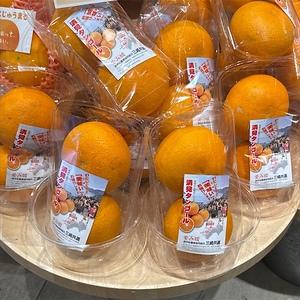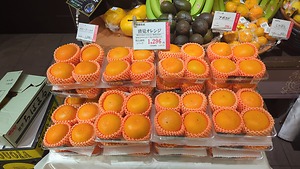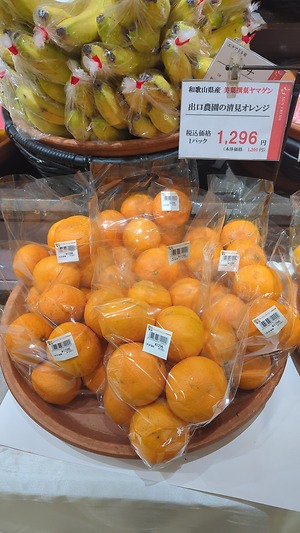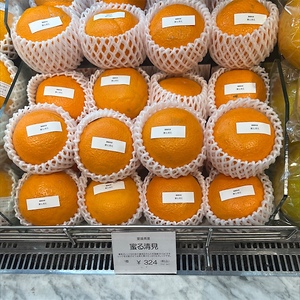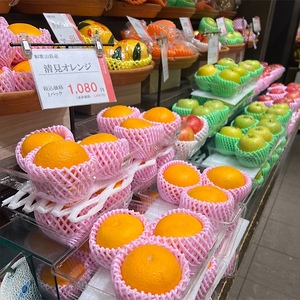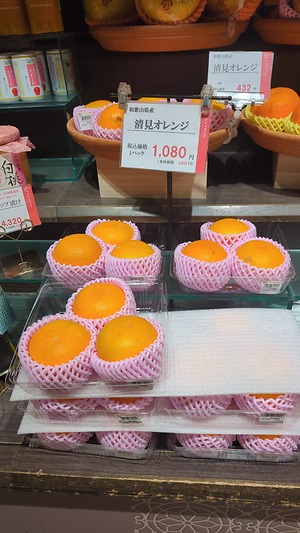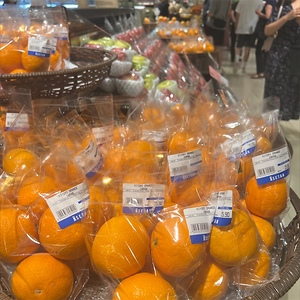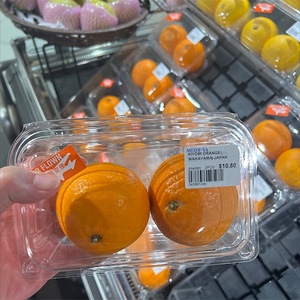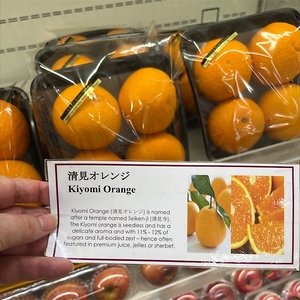


Kiyomi Oranges
Estimated Inventory, lb : 0
Description/Taste
Kiyomi oranges are a medium to large varietal, averaging 7 to 8 centimeters in diameter, and have an ovate to oblate shape. The oranges have a thin but somewhat tough and leathery, textured skin covered in large pores giving the surface a pebbled appearance. The orange rind is somewhat easy to peel, but due to the soft flesh, it will only break apart into small pieces, taking time to remove. Underneath the surface, the flesh is divided into 11 to 12 segments by thin membranes and is soft, aqueous, and tender with a pulpy, succulent consistency. The orange flesh is comprised of prominent juice vesicles that burst open when chewed, releasing aromatic juice, and the flesh is generally seedless, sometimes containing 1 to 2 seeds. Kiyomi oranges should have a slight give when squeezed and will feel heavy for their size, releasing a fragrant, citrus-forward aroma. The flesh has a high sugar content, ranging from 11 to 13 Brix, and moderate acidity, creating a mild, sweet, and subtly tart flavor.
Seasons/Availability
Kiyomi oranges are grown in greenhouses and open-air orchards, generally available in the late winter through early summer.
Current Facts
Kiyomi oranges, botanically classified as Citrus reticulata, are a Japanese variety belonging to the Rutaceae or citrus family. The cultivar was created in the late 20th century and was specifically bred to be a citrus with improved flavor, aroma, size, and texture. Kiyomi oranges are also known as Kiyomi tangors, a hybrid of a mandarin orange and a sweet orange, and were the first tangor developed in Japan. The oranges are grown in greenhouses and open-air orchards in Japan, and when cultivated outside, the oranges are individually placed in bags and allowed to fully ripen on the tree during the winter. Leaving the oranges on the tree for extended periods allows the fruits to develop their signature sweet flavoring and high juice content. Kiyomi oranges are also known for their use in citrus breeding. Since its release, Kiyomi oranges have been used as a parent variety in other famous Japanese citrus cultivars, including Dekopon, Amaka, Harumi, Nanpu, Harehime, Setoka, Amakusa, Akemi, Seiho, and Harumi. Kiyomi oranges are primarily consumed in fresh preparations and are savored for their soft, tender, and juicy flesh.
Nutritional Value
Kiyomi oranges are a source of vitamin C to strengthen the immune system, vitamin E to protect the cells against free radical damage, fiber to regulate the digestive tract, and vitamin A to maintain healthy organ functioning. The oranges also contain antioxidants to reduce inflammation and other nutrients, including magnesium, copper, and calcium.
Applications
Kiyomi oranges have a sweet, aromatic flavor suited for fresh and cooked preparations. The oranges can be peeled by hand, but the soft flesh often gets torn in the process, spilling juices. Most consumers choose to slice the oranges, or they can be halved and scooped out with a spoon, similar to a grapefruit. Kiyomi oranges can be served as a refreshing, stand-alone snack, sliced and tossed into green salads and fruit medleys, added to parfaits, or infused into salad dressings and sauces. Kiyomi oranges can also be pressed into juice, blended into smoothies, or infused into cocktails. In addition to fresh preparations, Kiyomi oranges can be simmered into jams, jellies, and preserves, cooked into sauces for meats, or incorporated as flavoring into cakes, sorbets, and other desserts. The oranges can also be juiced and used in candies, caramels, and syrups. In Japan, oranges are often used in a dessert known as kanten. This dessert is traditionally served during New Year's celebrations and is a gelatinous, jelly-like treat made from agar. Kiyomi oranges pair well with fruits such as strawberries, kiwis, cherries, grapes, and peaches, soy sauce, sesame, aromatics such as chile peppers, ginger, and garlic, cream, brown sugar, and herbs such as mint, fennel, coriander, and thyme. Whole, unwashed Kiyomi oranges can be kept for one week at room temperature or stored in the refrigerator's crisper drawer for several weeks.
Ethnic/Cultural Info
Kiyomi oranges were named after two scenic locations in the Okitsu neighborhood of the Shimizu-Ku ward within the Shizuoka Prefecture. Both landmarks of the region are located near the Okitsu Branch Fruit Research Station, the birthplace of Kiyomi oranges. The first location, Kiyomi-gata, is a bay and beach in Shimizu-Ku, and the second location is the temple Seiken-Ji. This temple is also known as Kiyomi-dera and is a Buddhist temple that overlooks the city, believed to have been constructed sometime during the Hakuchi Era. Seiken-Ji Temple is also home to a garden that was designated as a Place of Scenic Beauty by the Japanese government in 1936.
Geography/History
Kiyomi oranges were developed at the Fruit Research Station, Okitsu Branch, in Japan in 1949. The variety was created from a cross between a Satsuma mandarin and a Trovita orange, and the seedlings were studied for several years before they produced fruit in 1963. The variety was initially named Okitsu No. 21 in 1974 and was later registered as Tangor Norin No. 1 in 1979. After its release, Kiyomi oranges were commercially cultivated across Japan and were a favored variety for citrus breeding programs. The cultivar was also introduced into the United States in the 1980s. Budwood was given to the Citrus Variety Collection in Riverside, California, for further study and evaluation, but the variety was never distributed for commercial cultivation in the United States. Today Kiyomi oranges are mainly produced in the Ehime and Wakayama prefectures in Japan, followed by areas of cultivation in Hiroshima, Kumamoto, Oita, and Saga. The oranges are sold domestically and exported to other countries in Asia. The Kiyomi oranges featured in the photograph above were sourced from the Meidi-Ya supermarket in the Millenia Walk in Singapore. The oranges were air-flown from the Ehime Prefecture, Japan.



